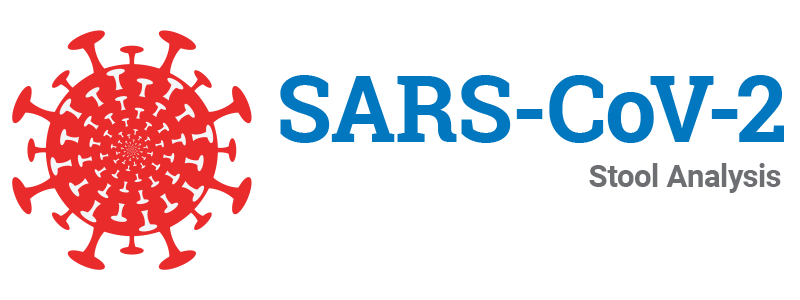Coronavirus Stool Testing
SARS-CoV-2 qPCR Stool Test from Diagnostic Solutions Laboratory
by Tom Fabian, PhD, CNTP, and Cass Nelson-Dooley, MS
Key Points
- Cutting-edge viral RNA qPCR stool test measures levels of SARS-CoV-2, the virus that causes COVID-19.
- SARS-CoV-2 in stool may be found in up to 53.4% of COVID-19 patients.
- The virus may be detected in stool for a period of days to weeks after initial infection.
- Intestinal viral infection may play an important role in COVID-19 disease progression and may increase risk for more severe disease.
- Detection of SARS-CoV-2 in stool could be used to prevent fecal-oral transmission.
High Fecal Viral Levels Found in COVID-19 Disease and in Asymptomatic Carriers
SARS-CoV-2, the virus that causes COVID-19, can be detected in the stool of up to 53.4% of COVID-19 patients.2-6 In about 23% of cases, patients were no longer positive for the virus in respiratory samples, yet stool samples were still positive,2 clearly underlining the value of fecal testing. Data from 98 COVID-19 patients showed viral shedding in stool for nearly five weeks after respiratory samples were negative.1 Another study reported that patients shed the virus in stool 30 days after initial infection.7 Even asymptomatic carriers may show elevated SARS-CoV-2 in stool.5 Therefore, Wu and colleagues recommend routine RT-PCR stool testing to determine when it is safe to discontinue precautions in recovered COVID-19 patients, so as to prevent transmission of the virus and best allocate medical resources.1
A Direct Link Between COVID-19 and Gastrointestinal Illness
SARS-CoV-2 gains entry into the host via the ACE2 protein, which is found not only in lung epithelia, but also gut epithelia. Therefore, the gut could present an entryway into the host and may be a site of viral infection.7 Indeed, two to eighteen percent of patients with COVID-19 had diarrhea, abdominal pain, and vomiting.7,8 Ten percent of patients presented with diarrhea and nausea one to two days before they developed fever and respiratory symptoms.2-6 And in some cases, digestive symptoms were the primary symptom of COVID-19.7 Further, GI symptoms with COVID-19 may indicate a more severe course of illness.7 For example, abdominal pain was reported more frequently in patients admitted to the intensive care unit.6 SARS-CoV-2 can also be detected in fecal specimens of asymptomatic patients.
Identify and Prevent Potential Fecal-Oral Transmission of COVID-19
The presence of SARS-CoV-2 in stool points to a potential fecal-oral transmission route for COVID-19.9 Asymptomatic individuals could therefore spread SARS-CoV-2 unknowingly, although this still remains to be proven. Potential fecal-oral transmission of COVID-19 presents risks for medical personnel having contact with patient stool. Additionally, endoscopic procedures could facilitate the transmission of SARS-CoV-2 through exposure to the virus in gastrointestinal tissues or mucus.10
The Gut-Lung Axis
The gut microbiome may have a role in lung health. In respiratory tract infections, pathogens invade the airways and multiply. Infection depends on the number and virulence of pathogens, but perhaps more importantly – the host's defenses.11 Acute respiratory infections such as influenza can initiate dysbiosis in the respiratory and gastrointestinal tracts, which may promote the development of secondary bacterial pneumonias.12 In some studies, oral probiotics have shown protective effects against influenza virus, pneumococcal infections, and ventilator-induced pneumonia.11 This points to a possible strategy of improving the gut microbiome to improve immune defenses and prevent respiratory infections.
Optimize Gut Health to Reduce the Impact of Coronavirus Infection
Given the role of SARS-CoV-2 in gastrointestinal infection, GI symptoms, and disease severity, a healthy GI tract could reduce infection and/or severity of COVID-19. By optimizing gut health, we may be able to protect patients from further complications caused by SARS-CoV-2.
Video posted April 9, 2020.
† Not approved or evaluated by the FDA. This test is for investigational or Research Use Only (RUO).
REFERENCES – Offsite Links Open in New Window
- Wu Y, Guo C, Tang L, et al. Prolonged presence of SARS-CoV-2 viral RNA in faecal samples. The lancet Gastroenterology – hepatology. 2020.
- Xiao F, Tang M, Zheng X, Liu Y, Li X, Shan H. Evidence for gastrointestinal infection of SARS-CoV-2. Gastroenterology. 2020.
- Young BE, Ong SWX, Kalimuddin S, et al. Epidemiologic Features and Clinical Course of Patients Infected With SARS-CoV-2 in Singapore. Jama. 2020.
- Zhang J, Wang S, Xue Y. Fecal specimen diagnosis 2019 novel coronavirus-infected pneumonia. Journal of medical virology. 2020.
- Xie C, Jiang L, Huang G, et al. Comparison of different samples for 2019 novel coronavirus detection by nucleic acid amplification tests. Int J Infect Dis. 2020;93:264-267.
- Tang A, Tong ZD, Wang HL, et al. Detection of Novel Coronavirus by RT-PCR in Stool Specimen from Asymptomatic Child, China. Emerg Infect Dis. 2020;26(6).
- Yeo C, Kaushal S, Yeo D. Enteric involvement of coronaviruses: is faecal-oral transmission of SARS-CoV-2 possible? The lancet Gastroenterology & hepatology. 2020;5(4):335-337.
- Pan L, Mu M, Yang P. Clinical characteristics of COVID-19 patients with digestive symptoms in Hubei, China: a descriptive, cross-sectional, multicenter study. The American journal of gastroenterology. 2020;Preproof.
- Yuen KS, Ye ZW, Fung SY, Chan CP, Jin DY. SARS-CoV-2 and COVID-19: The most important research questions. Cell Biosci. 2020;10:40.
- Repici A, Maselli R, Colombo M, et al. Coronavirus (COVID-19) outbreak: what the department of endoscopy should know. Gastrointestinal endoscopy. 2020.
- Gao Z, Kang Y, Yu J, Ren L. Human pharyngeal microbiome may play a protective role in respiratory tract infections. Genomics Proteomics Bioinformatics. 2014;12(3):144-150.
- Hanada S, Pirzadeh M, Carver KY, Deng JC. Respiratory Viral Infection-Induced Microbiome Alterations and Secondary Bacterial Pneumonia. Front Immunol. 2018;9:2640.

